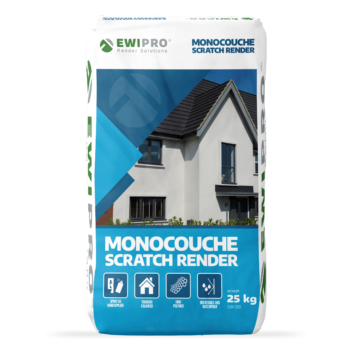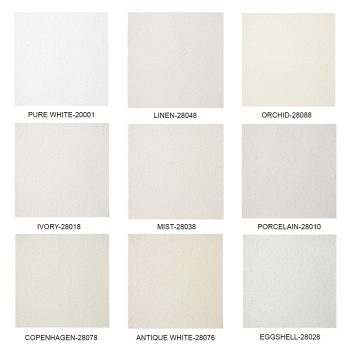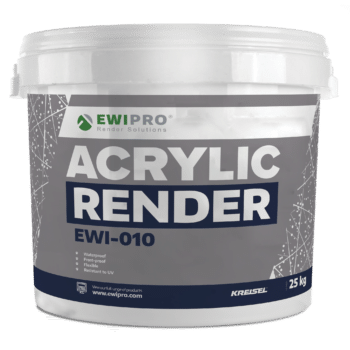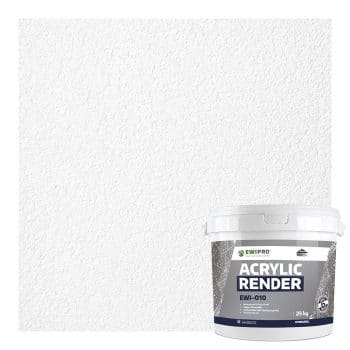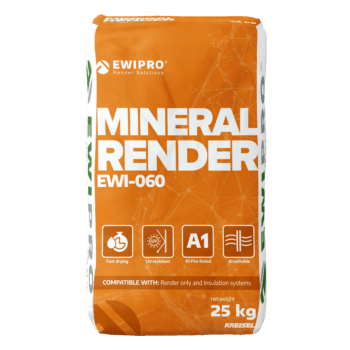How Does Silicone Render Stay Clean?
When it comes to choosing a render for your property, the ease of maintenance is an essential consideration. Silicone render, in particular, has gained popularity due to its self-cleaning properties, keeping your building’s façade looking pristine and fresh. In this blog, we will discuss the self-cleaning properties of silicone render, its hydrophobic qualities, and how it compares to other render types. We’ll also explore how to clean silicone, monocouche, acrylic, and mineral render, and the use of fungicidal washes to keep your building’s exterior in top condition.
Self-cleaning properties of Silicone Render
Silicone render is renowned for its self-cleaning properties, thanks to its unique chemistry. Unlike other render types, silicone render is formulated with silicone resins and water-repellent additives that give it hydrophobic characteristics. These properties cause water to bead up on the surface, preventing the absorption of moisture, dirt, and organic growth.
When it rains, the water droplets roll off the surface, picking up dirt and debris along the way. This process, known as the “lotus effect,” mimics the self-cleaning mechanism found in nature, such as the surface of a lotus leaf. Dr Wilhelm Barthlott coined the term and revealed ‘the lotus’ highly textured surface, which allows air to become trapped within its cavities. This eliminates the ability for condensation to form and enables the wind to move water droplets on the surface, sweeping dirt particles away in the process.’ (Naples Garden) The result is a cleaner façade that requires less maintenance, as the rain effectively washes away dirt and contaminants.
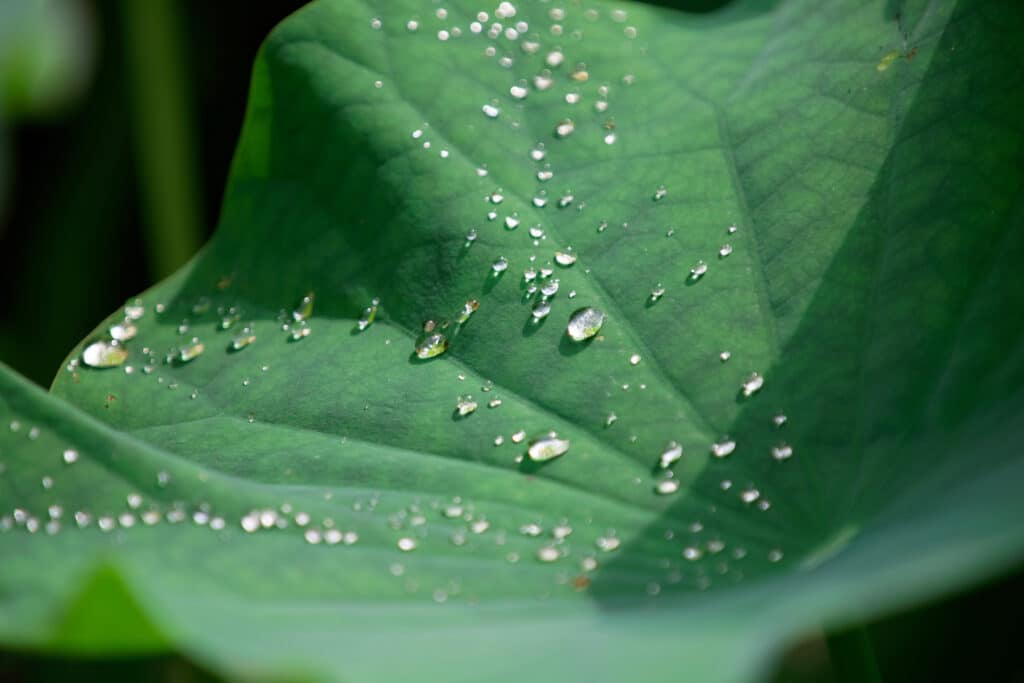
Hydrophobic qualities of Silicone Render
Silicone render’s hydrophobic qualities not only contribute to its self-cleaning properties but also offer several other advantages. By repelling water, silicone render prevents moisture ingress, which can lead to dampness and structural issues in the long run. This feature also helps the render to dry quickly after rain, reducing the likelihood of algae and mould growth.
Moreover, the hydrophobic nature of silicone render reduces the risk of efflorescence, a common issue with cement-based renders. Efflorescence occurs when salts within the render are drawn to the surface by moisture, creating unsightly white deposits. By repelling water, silicone render minimises the migration of salts, maintaining the façade’s appearance and structural integrity.

Hydrophobic surfaces are water-repellent and have a low affinity for water. Water droplets on these surfaces tend to bead up and easily roll off due to the surface’s nonpolar nature, creating a high contact angle. Hydrophilic surfaces, on the other hand, are water-attracting and have a high affinity for water. Water droplets on these surfaces spread out, forming a low contact angle. This is because hydrophilic surfaces have polar or charged regions that can form hydrogen bonds with water molecules.
Ways to clean Silicone, Monocouche, Acrylic, and Mineral Render
Despite silicone render’s self-cleaning properties, periodic cleaning may still be required to maintain the building’s appearance, especially in areas with high levels of pollution or airborne contaminants. The following methods can be used to clean various render types:
Silicone render: As silicone render is self-cleaning, it typically requires little maintenance. However, if cleaning is necessary, use a soft brush and mild detergent to gently remove dirt and debris. Avoid using pressure washers or harsh chemicals, as they can damage the render surface.
Monocouche render: Monocouche render is a through-coloured, single-coat render that can be cleaned using a soft brush and mild detergent. Be cautious when using pressure washers, as excessive pressure may damage the surface. Instead, opt for low-pressure washing techniques to minimise the risk of damage.
Acrylic render: Acrylic render is a flexible, synthetic render that can be cleaned using a soft brush, mild detergent, and water. Like silicone render, avoid using pressure washers or harsh chemicals, as they can cause damage to the surface.
Mineral render: Mineral render is a cement-based render that can be cleaned using a soft brush, mild detergent, and water. You can also use a low-pressure washer, but be careful not to apply too much pressure, as this can damage the render.
-
Monocouche Render (EWI-090) 25KG
Rated 4.80 out of 5From £14.39 Incl. VATFrom £11.99 Excl. VAT -
Silicone Render (EWI-075) – 25KG
Rated 4.83 out of 5From £83.99 Incl. VATFrom £69.99 Excl. VAT -
Acrylic Render (EWI-010) – 25kg
Rated 4.50 out of 5From £47.99 Incl. VATFrom £39.99 Excl. VAT -
Mineral Render (EWI-060) – 25kg
Rated 3.80 out of 5£24.00 Incl. VAT£20.00 Excl. VAT£38.51 Incl. VAT£32.09 Excl. VAT
Using Fungicidal Wash
Over time, renders may become susceptible to algae, mould, and mildew growth, especially in damp or shaded areas. To effectively clean and prevent organic growth, a fungicidal wash can be used on various render types, including silicone, monocouche, acrylic, and mineral render.
Fungicidal washes are specially formulated cleaning agents that contain active ingredients designed to kill and inhibit the growth of algae, mould, and mildew. These washes not only clean the surface but also provide a protective barrier, reducing the likelihood of future growth.
To use a fungicidal wash, follow these steps:
- Before application, ensure the render surface is free of loose debris, dirt, and dust. Use a soft brush to gently remove any buildup.
- Mix the fungicidal wash according to the manufacturer’s instructions. Typically, the wash should be diluted with water, with the concentration depending on the severity of the organic growth. However, EWI Store Fungicidal Wash is designed to be ready to use.
- Apply the fungicidal wash to the render surface using a low-pressure sprayer or soft brush. Be sure to cover the entire area, paying special attention to any heavily affected sections.
- Allow the fungicidal wash to dwell on the surface for the recommended time, as specified by the manufacturer. This dwell time ensures the active ingredients have enough time to effectively kill the organic growth.
- After the dwell time has elapsed, rinse the surface thoroughly with clean water. A low-pressure washer can be used for this step, but take care not to apply excessive pressure that may damage the render.
- Allow the surface to dry completely. The render should now be free of organic growth, and the protective barrier provided by the fungicidal wash will help prevent future occurrences.
To conclude
Silicone render is an excellent choice for property owners seeking a low-maintenance, long-lasting façade solution. Its self-cleaning and hydrophobic properties ensure a clean, attractive appearance with minimal effort. However, if additional cleaning is required, mild detergents, soft brushes, and fungicidal washes can be used to maintain the render’s pristine condition.
By understanding the unique characteristics of silicone render and how to care for it, you can enjoy a beautiful, low-maintenance exterior that stands the test of time.
Facebook
Twitter
LinkedIn
Your cart
Trade Account Login

We use cookies on our website to give you the most relevant experience by remembering your preferences and repeat visits. By clicking “Accept All”, you consent to the use of ALL the cookies. However, you may visit "Cookie Settings" to provide personalised consent.
Manage consent
Privacy Overview
This website uses cookies to improve your experience while you navigate through the website. Out of these, the cookies that are categorized as necessary are stored on your browser as they are essential for the working of basic functionalities of the website. We also use third-party cookies that help us analyze and understand how you use this website. These cookies will be stored in your browser only with your consent. You also have the option to opt-out of these cookies. But opting out of some of these cookies may affect your browsing experience.
Necessary cookies are absolutely essential for the website to function properly. These cookies ensure basic functionalities and security features of the website, anonymously.
| Cookie | Duration | Description |
|---|---|---|
| __stripe_mid | 1 year | This cookie is set by Stripe payment gateway. This cookie is used to enable payment on the website without storing any patment information on a server. |
| __stripe_sid | 30 minutes | This cookie is set by Stripe payment gateway. This cookie is used to enable payment on the website without storing any patment information on a server. |
| _GRECAPTCHA | 5 months 27 days | This cookie is set by the Google recaptcha service to identify bots to protect the website against malicious spam attacks. |
| apbct_cookies_test | session | CleanTalk sets this cookie to prevent spam on comments and forms and act as a complete anti-spam solution and firewall for the site. |
| apbct_page_hits | session | CleanTalk sets this cookie to prevent spam on comments and forms and act as a complete anti-spam solution and firewall for the site. |
| apbct_prev_referer | session | Functional cookie placed by CleanTalk Spam Protect to store referring IDs and prevent unauthorized spam from being sent from the website. |
| apbct_site_landing_ts | session | CleanTalk sets this cookie to prevent spam on comments and forms and act as a complete anti-spam solution and firewall for the site. |
| apbct_site_referer | 3 days | This cookie is placed by CleanTalk Spam Protect to prevent spam and to store the referrer page address which led the user to the website. |
| apbct_timestamp | session | CleanTalk sets this cookie to prevent spam on comments and forms and act as a complete anti-spam solution and firewall for the site. |
| apbct_urls | 3 days | This cookie is placed by CleanTalk Spam Protect to prevent spam and to store the addresses (urls) visited on the website. |
| AWSALBCORS | 7 days | This cookie is managed by Amazon Web Services and is used for load balancing. |
| cookielawinfo-checkbox-advertisement | 1 year | Set by the GDPR Cookie Consent plugin, this cookie is used to record the user consent for the cookies in the "Advertisement" category . |
| cookielawinfo-checkbox-analytics | 11 months | This cookie is set by GDPR Cookie Consent plugin. The cookie is used to store the user consent for the cookies in the category "Analytics". |
| cookielawinfo-checkbox-functional | 11 months | The cookie is set by GDPR cookie consent to record the user consent for the cookies in the category "Functional". |
| cookielawinfo-checkbox-necessary | 11 months | This cookie is set by GDPR Cookie Consent plugin. The cookies is used to store the user consent for the cookies in the category "Necessary". |
| cookielawinfo-checkbox-others | 11 months | This cookie is set by GDPR Cookie Consent plugin. The cookie is used to store the user consent for the cookies in the category "Other. |
| cookielawinfo-checkbox-performance | 11 months | This cookie is set by GDPR Cookie Consent plugin. The cookie is used to store the user consent for the cookies in the category "Performance". |
| ct_checkjs | session | CleanTalk–Used to prevent spam on our comments and forms and acts as a complete anti-spam solution and firewall for this site. |
| ct_fkp_timestamp | session | CleanTalk sets this cookie to prevent spam on the site's comments/forms, and to act as a complete anti-spam solution and firewall for the site. |
| ct_pointer_data | session | CleanTalk sets this cookie to prevent spam on the site's comments/forms, and to act as a complete anti-spam solution and firewall for the site. |
| ct_ps_timestamp | session | CleanTalk sets this cookie to prevent spam on the site's comments/forms, and to act as a complete anti-spam solution and firewall for the site. |
| ct_sfw_pass_key | 1 month | CleanTalk sets this cookie to prevent spam on comments and forms and act as a complete anti-spam solution and firewall for the site. |
| ct_timezone | session | CleanTalk–Used to prevent spam on our comments and forms and acts as a complete anti-spam solution and firewall for this site. |
| elementor | never | This cookie is used by the website's WordPress theme. It allows the website owner to implement or change the website's content in real-time. |
| viewed_cookie_policy | 11 months | The cookie is set by the GDPR Cookie Consent plugin and is used to store whether or not user has consented to the use of cookies. It does not store any personal data. |
Functional cookies help to perform certain functionalities like sharing the content of the website on social media platforms, collect feedbacks, and other third-party features.
| Cookie | Duration | Description |
|---|---|---|
| __zlcmid | 1 year | This cookie is used by Zendesk live chat and is used to store the live chat ID. |
| bcookie | 2 years | LinkedIn sets this cookie from LinkedIn share buttons and ad tags to recognize browser ID. |
| bscookie | 2 years | LinkedIn sets this cookie to store performed actions on the website. |
| lang | session | LinkedIn sets this cookie to remember a user's language setting. |
| lidc | 1 day | LinkedIn sets the lidc cookie to facilitate data center selection. |
| UserMatchHistory | 1 month | LinkedIn sets this cookie for LinkedIn Ads ID syncing. |
Performance cookies are used to understand and analyze the key performance indexes of the website which helps in delivering a better user experience for the visitors.
| Cookie | Duration | Description |
|---|---|---|
| __utma | 2 years | This cookie is set by Google Analytics and is used to distinguish users and sessions. The cookie is created when the JavaScript library executes and there are no existing __utma cookies. The cookie is updated every time data is sent to Google Analytics. |
| __utmb | 30 minutes | Google Analytics sets this cookie, to determine new sessions/visits. __utmb cookie is created when the JavaScript library executes and there are no existing __utma cookies. It is updated every time data is sent to Google Analytics. |
| __utmc | session | The cookie is set by Google Analytics and is deleted when the user closes the browser. It is used to enable interoperability with urchin.js, which is an older version of Google Analytics and is used in conjunction with the __utmb cookie to determine new sessions/visits. |
| __utmt | 10 minutes | Google Analytics sets this cookie to inhibit request rate. |
| __utmv | 2 years | The __utmv cookie is set on the user's device, to enable Google Analytics to classify the visitor. |
| __utmz | 6 months | Google Analytics sets this cookie to store the traffic source or campaign by which the visitor reached the site. |
| sib_cuid | 6 months | Purechat uses this cookie to send data to purechat.com, to connect visitors to the reservation team and track visitors to stay on portal. |
| SRM_B | 1 year 24 days | Used by Microsoft Advertising as a unique ID for visitors. |
Analytical cookies are used to understand how visitors interact with the website. These cookies help provide information on metrics the number of visitors, bounce rate, traffic source, etc.
| Cookie | Duration | Description |
|---|---|---|
| _ga | 2 years | The _ga cookie, installed by Google Analytics, calculates visitor, session and campaign data and also keeps track of site usage for the site's analytics report. The cookie stores information anonymously and assigns a randomly generated number to recognize unique visitors. |
| _gat_gtag_UA_61069204_2 | 1 minute | Set by Google to distinguish users. |
| _gat_UA-61069204-2 | 1 minute | A variation of the _gat cookie set by Google Analytics and Google Tag Manager to allow website owners to track visitor behaviour and measure site performance. The pattern element in the name contains the unique identity number of the account or website it relates to. |
| _gcl_au | 3 months | Provided by Google Tag Manager to experiment advertisement efficiency of websites using their services. |
| _gid | 1 day | Installed by Google Analytics, _gid cookie stores information on how visitors use a website, while also creating an analytics report of the website's performance. Some of the data that are collected include the number of visitors, their source, and the pages they visit anonymously. |
| _uetsid | 1 day | This cookies are used to collect analytical information about how visitors use the website. This information is used to compile report and improve site. |
| CONSENT | 2 years | YouTube sets this cookie via embedded youtube-videos and registers anonymous statistical data. |
Advertisement cookies are used to provide visitors with relevant ads and marketing campaigns. These cookies track visitors across websites and collect information to provide customized ads.
| Cookie | Duration | Description |
|---|---|---|
| _fbp | 3 months | This cookie is set by Facebook to display advertisements when either on Facebook or on a digital platform powered by Facebook advertising, after visiting the website. |
| ANONCHK | 10 minutes | The ANONCHK cookie, set by Bing, is used to store a user's session ID and also verify the clicks from ads on the Bing search engine. The cookie helps in reporting and personalization as well. |
| fr | 3 months | Facebook sets this cookie to show relevant advertisements to users by tracking user behaviour across the web, on sites that have Facebook pixel or Facebook social plugin. |
| MUID | 1 year 24 days | Bing sets this cookie to recognize unique web browsers visiting Microsoft sites. This cookie is used for advertising, site analytics, and other operations. |
| NID | 6 months | NID cookie, set by Google, is used for advertising purposes; to limit the number of times the user sees an ad, to mute unwanted ads, and to measure the effectiveness of ads. |
| test_cookie | 15 minutes | The test_cookie is set by doubleclick.net and is used to determine if the user's browser supports cookies. |
| uuid | 6 months | MediaMath sets this cookie to avoid the same ads from being shown repeatedly and for relevant advertising. |
| VISITOR_INFO1_LIVE | 5 months 27 days | A cookie set by YouTube to measure bandwidth that determines whether the user gets the new or old player interface. |
| YSC | session | YSC cookie is set by Youtube and is used to track the views of embedded videos on Youtube pages. |
| yt-remote-connected-devices | never | YouTube sets this cookie to store the video preferences of the user using embedded YouTube video. |
| yt-remote-device-id | never | YouTube sets this cookie to store the video preferences of the user using embedded YouTube video. |
| yt.innertube::nextId | never | This cookie, set by YouTube, registers a unique ID to store data on what videos from YouTube the user has seen. |
| yt.innertube::requests | never | This cookie, set by YouTube, registers a unique ID to store data on what videos from YouTube the user has seen. |
Other uncategorized cookies are those that are being analyzed and have not been classified into a category as yet.
| Cookie | Duration | Description |
|---|---|---|
| _clck | 1 year | No description |
| _clsk | 1 day | No description |
| _uetvid | 1 year 24 days | No description available. |
| AnalyticsSyncHistory | 1 month | No description |
| apbct_pixel_url | session | No description |
| apbct_visible_fields_0 | session | No description |
| apbct_visible_fields_1 | session | No description |
| apbct_visible_fields_10 | session | No description |
| apbct_visible_fields_2 | session | No description |
| apbct_visible_fields_3 | session | No description |
| apbct_visible_fields_4 | session | No description |
| apbct_visible_fields_5 | session | No description |
| apbct_visible_fields_6 | session | No description |
| apbct_visible_fields_7 | session | No description |
| apbct_visible_fields_8 | session | No description |
| apbct_visible_fields_9 | session | No description |
| ct_checked_emails | session | No description |
| ct_has_scrolled | session | No description |
| ct_mouse_moved | session | No description |
| ct_screen_info | session | No description |
| ictf_master | never | No description available. |
| li_gc | 2 years | No description |
| m | 2 years | No description available. |
| SM | session | No description available. |
| testinfinitycookie | session | No description |
| woocommerce_show_tax | 7 days | No description available. |
| wp_woocommerce_session_c5ac76b408021294cb56bcc27eddf8a1 | 2 days | No description |


